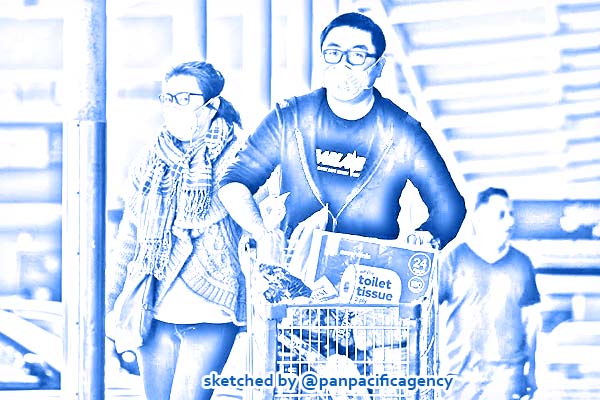New Zealand’s level 1 alert will lift major social distancing measures, but it’s unclear when and how officials will decide it

People wearing face masks leave a supermarket after buying supplies one day before the country goes on lockdown to stop any progress of the COVID-19 coronavirus, in Wellington. AFP. Sketched by the Pan Pacific Agency.
WELLINGTON, May 17, 2020, NZ Herald. Open schools and stores, busy playgrounds, takeaways and flat whites – level 2 might feel like freedom, but what does level 1 offer us? A quick glance at the four-tier system that’s become the core of our collective Covid-19 experience suggests little difference between this level and the one below it, New Zealand Herald reported.
Tough measures at the border continue, as do our efforts to test, trace and scrupulously practice good hygiene.
But look a little closer and the differences emerge.
An obvious one is public gatherings – the rules around which are to be reviewed at the end of this week.
There aren’t any restrictions for level 1, but anyone who’s visited their local cafe or tried to celebrate a kid’s birthday lately will know hard rules apply in the world of level 2.
The guest list for gatherings like weddings and baby showers can’t top 10; for funerals and tangihanga, the limit is now 50 – if all of those attendees are registered with the Ministry of Health.
For smaller get-togethers, the Government requires us to practice physical distancing, to keep a record of who we’ve caught up with.
And venues, which have to follow the same tracing guidelines, must stick to a capacity limit of 100.
Again, that largely comes back to distancing. Level 2 means we have to keep two metres away from people we don’t know, either on the street or in shops. In places like offices, gyms, libraries, pools and cinemas the rule becomes 1m.
There are no such distancing rules for Level 1 – nor are there for personal movement, and sports games and concerts are back on the menu.
In level 2, the official guidelines say sports and other activities are allowed, “subject to conditions on gatherings, record keeping, hygiene requirements and – where practical – physical distancing”.
When it comes to travel, we can drive or fly around level 1 New Zealand to our heart’s content – with the obvious exception that we keep away from crowded trains and buses if we’re sick or waiting on a Covid-19 test result.
Level 2 is more or less the same – but we’re still expected to keep our distance from others.
Hospitals, GP clinics and disability care services can go back to operating normally in level 1. Level 2 means they can “operate normally as far as possible”, but that still involves needing to follow strict guidelines about distancing and infection control.
Until level 1, doctors are expected to consult with their patients remotely whenever that’s possible.
Businesses are generally encouraged to find other ways of operating if they can throughout level 2, but can open if they meet all obligations around tracing, distancing and hygiene.
People at higher risk from Covid-19 are allowed to work and study, if they agree with their boss that they can do that safely.
For those businesses that involve a lot of “close contact” – a cafe, for instance – the Government expects “robust record-keeping, good hygiene practices and minimised contact to the extent possible”, otherwise they have to close.
Under level 1, public health measures like hand-washing still apply.
As for schools, universities and early learning centres under level 2 – class is back on, although a probable or confirmed case of Covid-19 means they have to close again immediately, as is the rule for level 1.
So, when do we all get to taste level 1?
The Government defines level 1 as when Covid-19 is “contained in New Zealand”, unlike level 2, when the disease is contained but risk of community transmission remains.
It’s unclear when and how officials will decide we’re there – but director general of health Dr Ashley Bloomfield said more days with no new cases will give his ministry confidence to back the move.